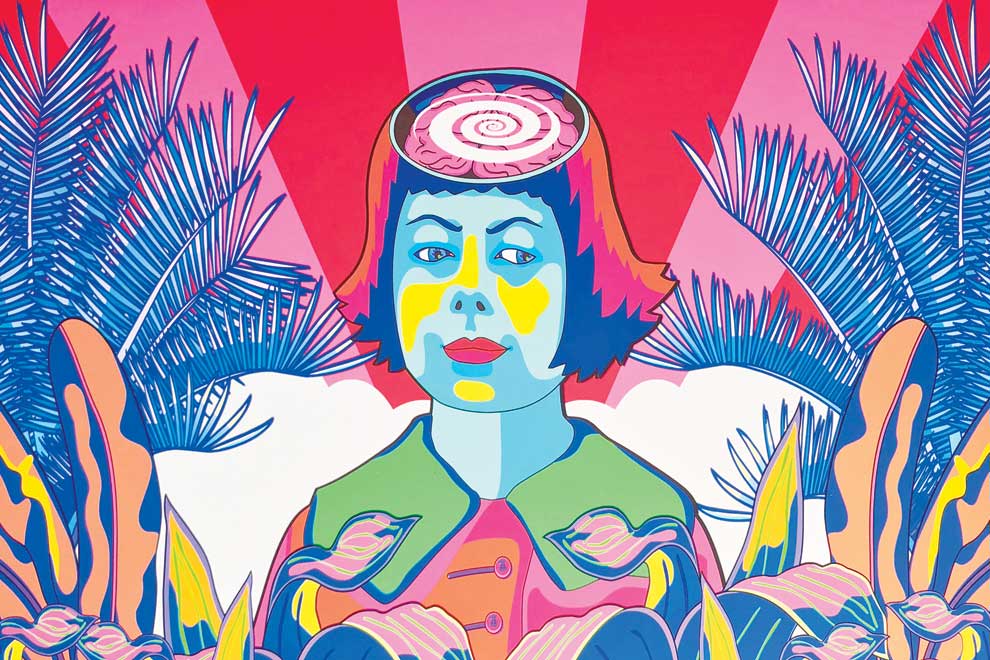
A print of She Stored Their Quirks, a depiction of American writer Carson McCullers. Photo supplied
UK-based artist Grande Dame (aka Tiff McGinnis) just can’t stick to one medium. Her trippy visuals take the form of animations, GIFs, pop prints, ceramics and textiles so saturated with neon they almost make your teeth ache. The genre-bending work is part Southern Gothic – an homage to her childhood roots in the American South – part ’60s and ’70s psychedelia, with a heavy dose of occult trash cinema and Roaring Twenties-era art nouveau sprinkled in for good measure.
To McGinnis, branching out artistically and thematically isn’t simply about creating more work – it’s also part of a grander life philosophy.
“We’re only on earth for who knows how long,” McGinnis explained over the phone, “I want to check out as many creative mediums as I can.”
She’s brought this ethos with her to Siem Reap, where her show Electric Crazyland will be making its Cambodian debut on Wednesday. McGinnis described a recent walk around the city during which she came upon a group of women deftly working over looms in an open-air storefront. It was a scene that struck her, and one that she said made her instantly want to add weaving to her collection of skills.
That’s just how McGinnis operates. Once she knows what she wants to do, she figures out how to make it happen. Her autodidactic tendencies have played a major role in the course of her evolution into “Grande Dame”. If you have a teacher, she explained, “you get the teacher’s taste, the teacher’s influences”.
McGinnis first started teaching herself animation out of necessity. In 2001 she moved to the United Kingdom to make music in the “electro-rock, punk scene” under the moniker “Crazy Girl”. She wanted videos to go along with her music, but the record label simply didn’t have the budget to hire someone to make them, so she improvised.

Artist Tiff McGinnis, or ‘Grande Dame’, pictured with her work. She opens an exhibition on Wednesday evening in Siem Reap. Nathan Thomas Jones
The progression from animating to selling prints was just as natural. Before YouTube existed, she would frequently email her videos to friends along with stills from the animations. The refrain she heard over and over again in response to the stills was “if you print that, I’ll buy it”.
Before long, animation overtook music as her medium of choice. These days almost all of her work either starts as an animation or ends up that way.
On opening night of the Siem Reap show, McGinnis will be projecting portions of a recent animation – a biography of Southern Gothic author Carson McCullers. McCullers, a contemporary of Truman Capote and Tennessee Williams, is best known for making extraordinary literature out of the lives of seemingly ordinary people.
“She gave black people a voice, she gave women a voice,” she said. McGinnis was also drawn to McCullers’s work because of her own roots in the deep American South.
McGinnis was born and raised in Georgia, in the US, and the soul of her artwork is still inextricably linked to the memories of her childhood there. She attributes a big part of her aesthetic to the psychedelic tastes of her parents. Her father was a Hi-Fi dealer who sold blacklight posters alongside light-up stereos. Those posters, many of which graced the walls of her childhood house, were some of the first pieces of art she ever saw.
One poster her parents owned in particular made an impression: a 1970s work titled Ain’t Gonna Work On Dizzy’s Farm No More by God Awful Graphics. The poster’s makers went on to be sued by the Walt Disney Company – for obvious reasons.
The art features cartoon icons Mickey Mouse, Donald Duck and Goofy sharing a hookah and looking less than sober. McGinnis herself still owns a copy of the irreverent print, to remind herself of her artistic origins.
Though the body of work on display has no connection to Cambodia, there is a chance her visit here might influence future pieces. So far, she says, she’s been in awe of the country’s sights and sounds.
“I feel like I’ve gone to another planet: planet paradise,” she said.
Before coming to the Kingdom, McGinnis did her best to learn about Cambodia’s artistic past. She said she had been particularly fascinated to learn about Cambodian rock ’n’ roll and its subsequent brutal decimation by the Khmer Rouge. McGinnis is so captivated by the story that she’s already seen the documentary Don’t Think I’ve Forgotten four times.
Reflecting on the creative richness she’s experienced here so far, McGinnis said, “my mind is blown”.
Electric Crazyland will open on Wednesday evening from 6pm at One Eleven Gallery, located in front of Vishnu Circle at the Old Market Bridge in Siem Reap. The exhibition will run until April 28.















